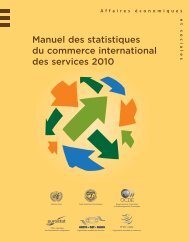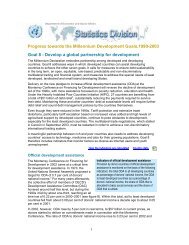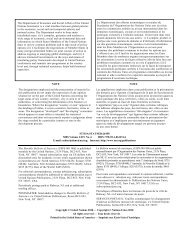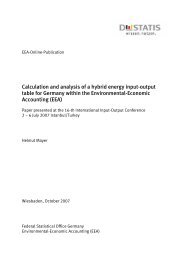dime NOTE The designations employed and the presentation of ...
dime NOTE The designations employed and the presentation of ...
dime NOTE The designations employed and the presentation of ...
- No tags were found...
You also want an ePaper? Increase the reach of your titles
YUMPU automatically turns print PDFs into web optimized ePapers that Google loves.
Data definitionsAagricultural production index: Based on <strong>the</strong> sum <strong>of</strong> priceweightedquantities <strong>of</strong> different agricultural commoditiesproduced after deductions <strong>of</strong> quantities used as seed <strong>and</strong>feed weighted in a similar manner. All <strong>the</strong> indices at <strong>the</strong>country, regional <strong>and</strong> world levels are calculated by <strong>the</strong>Laspeyres formula. Production quantities <strong>of</strong> eachcommodity are weighted by average internationalcommodity prices in <strong>the</strong> base period <strong>and</strong> summed for eachyear. To obtain <strong>the</strong> index, <strong>the</strong> aggregate for a given year isdivided by <strong>the</strong> average aggregate for <strong>the</strong> base period. <strong>The</strong>commodities covered in <strong>the</strong> computation <strong>of</strong> indices <strong>of</strong>agricultural production are all crops <strong>and</strong> livestock productsoriginating in each country. Practically all products arecovered, with <strong>the</strong> main exception <strong>of</strong> fodder crops (1 * , 2003,p. xvii).agricultural products: CPC Vers.1.1 (7), divisions 1 <strong>and</strong> 2:cereals, vegetables, fruit <strong>and</strong> nuts, oil seeds <strong>and</strong> oleaginousfruit, living plants, cut flowers <strong>and</strong> flower buds, flowerseeds <strong>and</strong> fruit seeds, vegetable seeds, beverages <strong>and</strong> spicecrops, unmanufactured tobacco, sugar beet <strong>and</strong> sugar cane,raw vegetable materials not elsewhere classified, liveanimals <strong>and</strong> animal products.Bbase period: <strong>The</strong> period <strong>of</strong> time for which data used as <strong>the</strong>base <strong>of</strong> an index number, or o<strong>the</strong>r ratio, have been collected.This period is frequently one year but it may be as short asone day or as long as <strong>the</strong> average <strong>of</strong> a group <strong>of</strong> years (5).birth rate, crude: <strong>The</strong> fraction where <strong>the</strong> numerator is <strong>the</strong>total number <strong>of</strong> births in a population during a given period<strong>and</strong> <strong>the</strong> denominator is <strong>the</strong> total number <strong>of</strong> person-yearslived by <strong>the</strong> population during that period, generallyapproximated by <strong>the</strong> size <strong>of</strong> <strong>the</strong> population at <strong>the</strong> mid-point<strong>of</strong> <strong>the</strong> period multiplied by <strong>the</strong> length <strong>of</strong> <strong>the</strong> period in years.Usually stated per 1,000 (18). Live birth is <strong>the</strong> completeexpulsion or extraction from its mo<strong>the</strong>r <strong>of</strong> a product <strong>of</strong>conception, irrespective <strong>of</strong> <strong>the</strong> duration <strong>of</strong> <strong>the</strong> pregnancy,which, after such separation, brea<strong>the</strong>s or shows any o<strong>the</strong>revidence <strong>of</strong> life, such as beating <strong>of</strong> heart, pulsation <strong>of</strong> <strong>the</strong>umbilical cord, or definite movement <strong>of</strong> voluntary muscles,whe<strong>the</strong>r or not <strong>the</strong> umbilical cord has been cut or <strong>the</strong>placenta is attached (23, definition 3.1).Ccapital goods: Pure-bred breeding animals, metal containersfor storage or transport, h<strong>and</strong> tools, armoured <strong>and</strong> reinforcedsafes <strong>and</strong> <strong>the</strong> like <strong>of</strong> base metal, boilers <strong>and</strong> auxiliary plant,turbines, engines <strong>and</strong> motors, agricultural <strong>and</strong> horticulturalor forestry machinery, construction <strong>and</strong> mining machinery,manufacturing machinery, self-propelled works trucks <strong>and</strong>______________*Numbers in paren<strong>the</strong>sis refer to numbered entries in <strong>the</strong> list <strong>of</strong>references which follow <strong>the</strong> data definitions section.o<strong>the</strong>r lifting, h<strong>and</strong>ling, loading or unloading machinery,weighing machinery <strong>and</strong> o<strong>the</strong>r appliances, <strong>of</strong>fice machines,audio <strong>and</strong> video apparatus <strong>and</strong> telecommunicationsequipment, electrical machines <strong>and</strong> apparatus, transportationinstallations <strong>and</strong> floating structures, boilers, devices,appliances <strong>and</strong> instruments, meters <strong>and</strong> o<strong>the</strong>r measuringinstruments <strong>and</strong> apparatus, cinematographic cameras <strong>and</strong>projectors, time measurement instruments, amusementequipment, <strong>of</strong>fice or desk equipment <strong>of</strong> base metal, tailors’dummies <strong>and</strong> displays, motorcars <strong>and</strong> o<strong>the</strong>r motor vehicles,trailers <strong>and</strong> semi-trailers, containers specially designed <strong>and</strong>equipped for transport, rail locomotives, tenders, coaches,railway or tramway passenger coaches, freight <strong>and</strong>maintenance cars, helicopters, space craft (includingsatellites) <strong>and</strong> spacecraft launch vehicles, balloons <strong>and</strong>dirigibles, tankers, fishing vessels, refrigerated vessels,ships, tugs, outboard motors, bicycles, trailers, aeroplanes<strong>and</strong> o<strong>the</strong>r aircraft, gliders, rowing boats <strong>and</strong> canoes, rafts(8, divisions 4 <strong>and</strong> 5).cement: CPC Vers. 1.1 (7): Cement, lime <strong>and</strong> plaster (group374).CIF (Cost, insurance, freight): <strong>The</strong> seller must pay <strong>the</strong> costs<strong>and</strong> freight necessary to bring <strong>the</strong> goods to <strong>the</strong> named port<strong>of</strong> destination but <strong>the</strong> risk <strong>of</strong> loss <strong>of</strong> or damage to <strong>the</strong> goods,as well as any additional costs due to events occurring after<strong>the</strong> time <strong>the</strong> goods have been delivered on board <strong>the</strong> vessel,is transferred from <strong>the</strong> seller to <strong>the</strong> buyer when <strong>the</strong> goodspass <strong>the</strong> ship's rail in <strong>the</strong> port <strong>of</strong> shipment. In addition, <strong>the</strong>seller has to procure marine insurance against <strong>the</strong> buyer'srisk <strong>of</strong> loss <strong>of</strong> or damage to <strong>the</strong> goods during <strong>the</strong> carriage.<strong>The</strong> seller contracts for insurance <strong>and</strong> pays <strong>the</strong> insurancepremium. <strong>The</strong> buyer should note that under <strong>the</strong> CIF term <strong>the</strong>seller is only required to obtain insurance on minimumcoverage. <strong>The</strong> CIF term requires <strong>the</strong> seller to clear <strong>the</strong> goodsfor export. This term can only be used for sea <strong>and</strong> inl<strong>and</strong>waterway transport (11).civil aviation traffic: Traffic for which remuneration isreceived, carried on flights performed according to apublished timetable <strong>and</strong> by extra flights occasioned byoverflow traffic from scheduled flights (2).construction: Economic activity directed to <strong>the</strong> creation,renovation, repair or extension <strong>of</strong> fixed assets in <strong>the</strong> form <strong>of</strong>buildings, l<strong>and</strong> improvements <strong>of</strong> an engineering nature <strong>and</strong>o<strong>the</strong>r such engineering constructions as roads, bridges, dams(13, para. 15). New construction refers to site preparationfor, <strong>and</strong> construction <strong>of</strong>, entirely new structures <strong>and</strong>/orsignificant extensions to existing structures whe<strong>the</strong>r or not<strong>the</strong> site was previously occupied. Within this class <strong>of</strong>construction, fur<strong>the</strong>r distinctions may be made by <strong>the</strong>following categories: residential buildings, so classifiedwhen more than half <strong>of</strong> <strong>the</strong> floor area <strong>of</strong> <strong>the</strong> building isintended for dwelling purposes; non-residential buildings(all buildings not classified as residential) (13, para. 73).October 2010 – octobre 2010 320












